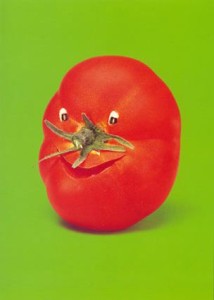Sorenne and I continued with our gardening this morning, concluding that it was finally warm enough to plant some cold tolerant crops down in the main garden. We also noticed that several of our herbs are emerging from seed.
I find rosemary the most versatile for cooking, but basil and cilantro have their roles. Unfortunately, basil and cilantro are particularly prone to bacterial contamination, even in home gardens (Sorenne, the snails are back).
Recognizing the number of recalls and outbreaks, the U.S. Food and Drug Administration issued guidance on March 31, 2011 for those who grow, harvest, sort, pack or ship fresh cilantro.
Some highlights are below. The complete document is available at:
http://www.fda.gov/Food/GuidanceComplianceRegulatoryInformation/GuidanceDocuments/ProduceandPlanProducts/ucm249401.htm
FDA is concerned about positive sample findings for human pathogens in fresh cilantro and recommends that this produce industry segment take action to .jpg) enhance the safety of these products.
enhance the safety of these products.
Since 2004, FDA has confirmed the presence of Salmonella species in 28 samples of fresh cilantro that was in, or entering into, commerce. The samples of fresh cilantro were of both U.S. and non-U.S. origin.
Fresh cilantro is commonly consumed in its raw state without processing or cooking to adequately reduce human pathogens. The manner in which it is grown, harvested, sorted, packed, and shipped is crucial to ensure that the potential for microbial contamination is minimized, thereby reducing the potential risk of illness to consumers.
In 1998, FDA issued a “Guide to Minimize Microbial Food Safety Hazards for Fruits and Vegetables,” (Ref. 3; the GAPs Guide). The GAPs Guide recommends good agricultural practices (GAPs) and good manufacturing practices (GMPs) that growers, harvesters, sorters, packers, and shippers can use to address risk factors common to the growing, harvesting, washing, sorting, packing, and transporting of fresh fruits and vegetables and thereby minimize food safety hazards potentially associated with fresh produce.
“… in view of continued positive findings for Salmonella spp. in fresh cilantro, FDA recommends that firms in the fresh cilantro industry review their current operations in the context of the GAPs Guide, as well as other available information regarding adequately reducing pathogens in or on fresh produce. We further encourage these firms to assess hazards unique to the production of cilantro and to develop commodity-specific preventive control strategies that would identify potential hazards that may be specific to fresh cilantro. Since the available information .jpg) concerning some of the recent positive findings for Salmonella spp. does not definitively identify the point of origin of the contamination, we recommend that firms take these steps for all points from the farm through distribution.
concerning some of the recent positive findings for Salmonella spp. does not definitively identify the point of origin of the contamination, we recommend that firms take these steps for all points from the farm through distribution.
References
1. FDA. 2010. Compliance Policy Guide Sec. 527.300, Dairy Products – Microbial Contaminants and Alkaline Phosphatase Activity.1
2. FDA. 1995. Compliance Policy Guide Sec 555.300, Foods, Except Dairy Products – Adulteration with Salmonella (CPG 7120.20)2.
3. FDA. 1998. Guide to Minimize Microbial Food Safety Hazards for Fruits and Vegetables.3
4. Institute of Food Technologists. 2001. Analysis and Evaluation of Preventive Control Measures for the Control and Reduction/Elimination of Microbial Hazards on Fresh and Fresh-Cut Produce4.
5. FDA. 2004. Letter to Firms that Grow, Pack, or Ship Fresh Lettuce and Fresh Tomatoes.5
6. FDA. 2005. Letter to California Firms that Grow, Pack, Process, or Ship Fresh and Fresh-cut Lettuce.6
7. FDA. 2009. Letter to Seed Suppliers, Distributors, and Sprouters.7
8. International Fresh-Cut Produce Association, Produce Marketing Association, United Fresh Fruit and Vegetable Association, Western Growers. Commodity Specific Food Safety Guidelines for the Lettuce and Leafy Greens Supply Chain – 1st Edition.8
9. Commodity specific Food Safety Guidelines for the Production, Harvest, Post-Harvest, and Valued-Added Unit Operations of Green Onions9
10. FDA. 2009. Guidance for Industry: Guide to Minimize Microbial Food Safety Hazards of Melons; Draft Guidance.10
11. FDA. 2009. Guidance for Industry: Guide to Minimize Microbial Food Safety Hazards of Tomatoes; Draft Guidance.11
12. FDA. 2009. Guidance for Industry: Guide to Minimize Microbial Food Safety Hazards of Leafy Greens; Draft Guidance.12
 Starmer has been the AMS administrator since January, succeeding Anne Alonzo in the post. Previously, she had served as senior advisor to Agriculture Secretary Tom Vilsack.
Starmer has been the AMS administrator since January, succeeding Anne Alonzo in the post. Previously, she had served as senior advisor to Agriculture Secretary Tom Vilsack.




.jpg) enhance the safety of these products.
enhance the safety of these products..jpg) produce industry overseas. The study will also look at how contaminants from these sources that might be introduced to fresh produce are currently controlled.
produce industry overseas. The study will also look at how contaminants from these sources that might be introduced to fresh produce are currently controlled. According to a World Bank
According to a World Bank